|
1. Mandir There was almost no light left as my traveling companions and I departed from the village, rumbling along that strange hilly road whose edges were now even more obscured by dust and darkness. I think we were all quiet for some minutes then, allowing the strangeness and mystery of the place to sink into us a bit longer. Or perhaps only I was quiet, sitting there in the front seat and watching the shadowy dunes drift by, while my buddies were pleasantly chatting in the back seat. The three of them, Irfan, Naz, and Khatau Jani, all squished together in that small space into one affable lump of friendliness. And I should also count our driver, Hanif, among my companions, because he was also a pleasant presence in all these various scenes that I am describing. As we left that broad wild desert terrain and reentered the narrow streets of the city, I inquired as to what we were doing next. “We are going to visit that mandir!” answered Naz. And I recalled that earlier in the day, my buddies had asked around to find out what times prayers would be offered at the Hindu temples (mandirs) in the city, and they had determined that the Shri Krishna Mandir would be holding prayers at just the right time in the evening. I cannot remember now how many mandirs there are in Mithi, though I did ask -- it was something like 8 or 10, perhaps. In any case, it needs to be a substantial number, to serve the majority Hindu community in Mithi (see my previous blog entry for a bit more on that topic).  Night barber in Mithi. Night barber in Mithi. Even in my travels in other parts of Sindh, where Hindus are a small minority, I have been given many opportunities to learn about Hindu worship in Pakistan. Eventually I will write up an account of my earlier visit to the beautiful Saadh Bello mandir in Sukkur, for example -- a golden-yellow temple that floats on a small island in the middle of the Indus. And I have also visited the shrine of Udero Lal, near Bhit Shah, where a Hindu holy site stands adjoining a Muslim shrine, connected by a small courtyard. Both of those visits deserve attention in their own right -- but I mention them now in order to make it clear that Hinduism and other minority religions too are very much alive in Pakistan, even though it is an Islamic Republic. Others may comment on the difficulty of being a member of a minority in this Islamic nation, and I do not deny those difficulties -- but another reality is just as clear to me, which is that the majority of Pakistanis respect and honor all faiths in their hearts. Most of my Muslim friends, when I ask them about these topics, answer sincerely that their own strong faith in Allah commands them also to be respectful of other faiths, and to look upon all humanity as one.  Children buying Diwali firecrackers. Children buying Diwali firecrackers. So -- this visit was not going to be my first visit to a Hindu temple in Sindh, but it would still be unique, because I had not yet witnessed any prayers or rituals inside one of these temples. There was also a special energy humming around the dimly lit streets of the city, because it was just a few days before Diwali, and the local children were buzzing around street vendors’ carts, picking out their favorite sparklers and firecrackers for the holiday. And quite a number of impatient firecrackers could be heard to go off that evening as well. Our car stopped in one of countless shadowy and bustling streets in the city of Mithi, near the Press Club, which would be our destination a little later when the inevitable need for tea would arise. From this spot we could easily walk to the mandir in question -- easily in terms of distance, though the walk was a bit harrowing to me in another sense. There is no separate place for pedestrians to walk in those narrow streets -- not here or in any typical Sindhi town. So people of all ages traveling on foot must share the path with vehicles of all sorts and moving in all possible directions -- cars, motorcycles, carts, and not a small number of wandering cows and bulls (a sacred symbol, of course, in Hindu Mithi). Of these, the only ones that I find genuinely stressful are the motorcycles, which seemed to rev about with wild abandon, squeezing themselves suddenly through tiny spaces between pedestrians. Avoiding their paths seems to be second nature to my Sindhi friends, but for me it is a rather enervating pursuit, especially in such darkness, where tripping on stationary things is also a distinct possibility. But I did my best to stay close to where my buddies were walking, and managed to get by without any unexpected tumbles or collisions. “It is useful that you are dressed locally!” Naz was saying as we dodged along the alleyway. “Yes, that was intentional,” I responded. I was wearing a very simple traditional suit that day, modest and loose-fitting, with colorful embroidery and mirrorwork. All of the Sindhi clothes that I wear are gifts that I have received from family and beloved friends, and of these, the majority are traditional in style, meaning that they are examples of Sindhi handicraft -- and not necessarily the sort of clothing that urban women in Sindh wear on a daily basis. But I’ll save the differences between those kinds of attire for some other blog post. Suffice it to say that the outfit I had chosen for that day not only disguised my Western-ness, but also my modern-ness, making me appear -- at least from a distance -- something like a local. And though the lightness of my skin always draws the attention of those who notice, there is never any hesitation among Sindhi people to accept me as one of their own, and quickly, seeing that I am comfortable in their cultural attire.  The writing above the entrance reads "Shri Krisha Mandir." The writing above the entrance reads "Shri Krisha Mandir." Along one of these dark streets, the walls opened in a high archway, through which a walkway ascended at a steep grade. This was our mandir. Up this ramping walkway was a colorful though shadowy courtyard, where we took off our shoes. It was not as dark here as on the street, however, because much light was escaping from within the mandir itself, where there was no shortage of illumination. We moved inward toward that light, ringing the hanging bell on our way. Some of my readers may be unfamiliar with Hindu temple bells -- and I am sure that there is much more symbolism in them than I am yet aware. But I can offer for the moment that it is believed that sounding the bell will wake the Gods inside and prepare them to hear your prayer. But I think there is much more meaning in these bells than that -- notions of time and peace and vibration and divinity -- which perhaps I will learn more about in the future. 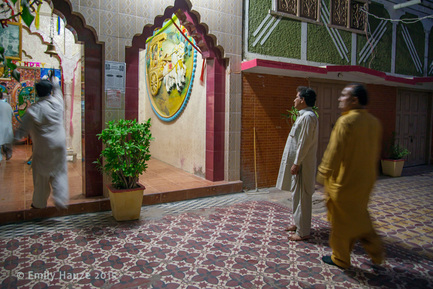 Inner courtyard and bell. Inner courtyard and bell. Actually, the impressions that I can offer from that evening in the mandir are in general just as hazy and naive as my above description of the temple bells -- though I believe they are still worth sharing. I do not pretend to be an expert (about this or any other aspect of Sindh, really) -- instead, what merit my observations might have comes from the freshness of my naive perspective. Inside the mandir, there is really only one thing (apart from the highly decorative walls), and that is the central shrine. In this case, the shrine is not in the very center of the room, but not up against the far wall either -- the reason for that being, I would soon discover, that it is necessary to be able to walk behind it, and to circle all around it. The statue of the god in the shrine itself is, to the best of my understanding, the most important element of the temple. In this case, of course, it is a statue of Krishna, though in other temples you would find other gods -- the powerful Shiva, Ganesh with his elephant head, the monkey-god Hanuman, etc. And it is believed that these gods come to inhabit their statues during worship; thus offerings are made to the statues, and incense and candles lit in their honor. (Again I want to stress that my understanding of the subject is minimal, but that I know there are thousands of layers of symbolism and complexity to all this, which can be understood by those who wish to learn.) But it was a fortunate coincidence for me that the iconography of this particular temple was all devoted to Krishna and his associates, simply because Krishna happens to be the Hindu god with whom I am most familiar. Through my study of kathak dance and rudimentary knowledge of the Mahabharata, I can at least identify Krishna as the blue-skinned god of the dance, playing his flute to the delight of his love-intoxicated Gopinis (cow-herding girls); I can recognize him by his peacock feather and his bansuri (wooden flute), and I can identify the woman at his side as Radha, his partner and beloved. And these were the scenes illustrated on the walls of his mandir. 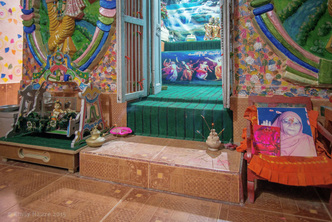 Base of the shrine. Base of the shrine. At first, my buddies and I were the only people inside the temple, apart from one or two men who seemed to be priests or caretakers of the place, and my buddies were chatting with them cordially. I think it’s worth emphasizing here again that this was a moment of genuine interfaith exchange -- because out of the four of us (Naz, Irfan, Khatau Jani, and me), only Khatau is a Hindu. My Muslim friends treat the mandir with respect and reverence, and they are just as eager to share Hindu traditions with me (their foreign Christian friend) as they are to explain their own religious customs. And for Khatau, there was clearly nothing unusual in inviting his non-Hindu friends to come to a mandir with him. There seemed to be no difference between us all; we were all part of the same human fabric. I came to realize around this point that the reason the interior of the temple was empty was that the worshippers were gathering outside and preparing to enter. Naz alerted me to this fact and I went out to watch and to record the proceedings. A small crowd of people of various ages, men children, had gathered with candles at the door of the mandir. (In my memory there were women also - but my video doesn’t reveal any. Possibly they were present but avoided my camera.) They began by ringing that bell loudly and persistently, adding also to that sound-texture repeated strikes against a small gong, and tones from a kind of a fluty whistle. Then they entered the temple and stood before the shrine, where they began to sing. It was a chant, I suppose, and not a song, but they sang it with full voices, invoking words that they all must have memorized long ago. They sang most of the lines in unison, but at key moments they broke into two-part harmony. After a few verses had past, a gentleman who seemed to be the leader came forward and received a tray with a candle from within the shrine. He swayed it in circular motions as the chant continued, and then eventually led the group in a procession around and around the shrine, all still singing, but now and again pausing from their circling walk in order to touch the small cradles that swing at the base of the shrine.
service may feel exotic to you (if you are not Hindu), I think you will still recognize some things that are familiar and common to worship in all religions: a sense of awareness of a group and a sincerity in supplication; an invocation of something very ancient; a natural pacing and rhythm of ritual -- a pace to which boisterous young children have a hard time adjusting themselves (and children are indeed the same across the globe!). 2. Lights, then Music 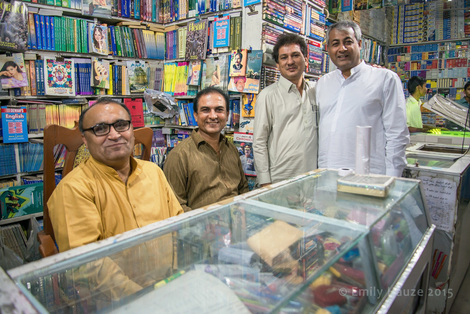 Naz (left) and Irfan (right) with the bookstore owners, Khatau Jani and his brother. Note the active photocopier in the background. Naz (left) and Irfan (right) with the bookstore owners, Khatau Jani and his brother. Note the active photocopier in the background. Our next destination would be the Mithi Press Club, but we stopped along the way at a brightly-lit bookshop that seemed a colorful oasis in those dark streets of the city, by virtue of its densely lined walls of brightly colored (mostly Sindhi) books. It was explained to me that this shop was owned by Khatau Jani’s family and run (I think) by his brother Kishore (if I am remembering his name right). That family connection seemed enough reason to stop in, but I soon realized that we had a more pragmatic goal to accomplish, which was to make a photocopy of my passport. The guest house where we were staying had asked for such a copy, so I had entrusted my passport to Naz earlier in the day. But photocopiers, it turns out, are a little bit hard to come by in Mithi, and that was the reason we had come specifically to this bookstore to make a copy. So that was a brief stop, and our tea in the Press Club was also brief and pleasant, and probably not worthy of further narration here. I may at some time return to the phenomenon of the “Press Club,” which seems to have a greater significance in the journalistic community in Sindh than it does in America - but that’s for another time. I will offer this shadowy photographic impression of the Mithi Press Club, however, which contains almost my entire memory of the place: This was the last that I would see of the inner city of Mithi, for this trip, anyway. It was by this point about 8:00 in the evening, which is still a bit early for dinner (by Pakistani standards, anyway). So my buddies told Hanif to drive us to a place called Gaddhi Bhit, which translates roughly to “High Dune.” A wide plateau has been leveled upon this high dune, with a big open space (seems like it would be perfect for concerts, though from what I gathered it isn’t often used that way) next to a large monument of relatively recent construction. The monument itself forms a partial wall at the edge of the mound’s plateau, intercut with archways, beyond which you can see all the lights of the city of Mithi as it lies nestled into the desert. I sat down on the floor of this arched monument for a while, looking out at the expanse in the darkness. My buddies were standing somewhere nearby, chatting pleasantly as they do. I think they are probably used to these moments when I sit slightly apart, in silence -- at least, they don’t seem bothered by it. I think they know that it is not a sign that I am moody or unhappy, but merely that I need some time to absorb everything. While I am in Sindh, I try to be like a sponge. I take in as much of that universe as I possibly can, so that I can bring it all back with me, and present it all again here in my blog, and tell the stories to anyone I meet. In these several quiet minutes, sitting cross-legged on the cool stone floor of the monument, I was not re-playing any specific episode in my mind, but simply inviting it all to sink in a bit deeper. And I was absorbing this new scene as well, the blanket of dimly glowing lights from this lovely small city below.  Drummer Boy of Gaddhi Bhit. Drummer Boy of Gaddhi Bhit. In my stillness I only gradually became aware of a rhythmic thumping sound coming from somewhere behind me, on the other side of the monument. I got up to see what it was. Around the corner I found my buddies watching a small boy with a double-skinned drum slung round his neck and long drumsticks in his hands. In that low half-light, the expressionless boy seemed to be some sort of apparition, gravely beating the two sides of his drum. My first impression was that he was all alone there, a ghost of the Gaddhi Bhit, though I think that in actuality he had some family nearby in the periphery. When he stopped playing, my buddies congratulated him and gave him a few rupees. Khatau Jani was looking at his watch, and I heard my buddies saying something about “roshni” (light), though I wasn’t sure of the rest of what they had said. “Soon the lights will come on in the city!” Naz explained to me, as we all turned our attention back out to the city view. That’s when I understood why the city streets had seemed so unusually dark to me while we were walking down below, and why the urban scene was only dimly glowing at this point. Of course there could be no other answer: load shedding. For those unfamiliar with Pakistan (and who haven’t read my other blog posts), load shedding is the result of the country’s dire electricity shortages. Most cities have to tolerate several hours per day without electricity, usually at fixed times so that you can anticipate the cut. During those hours, people have to fend for themselves, resorting to generators and large batteries. So, Mithi had been glowing dimly thus far because it was running on only auxiliary power. And now, just as Khatau predicted, all at once, the city doubled or tripled its brightness, as electricity was restored - and that dim city was dim no more. This long and eventful day is beginning to draw to a close -- but not quite yet. My buddies had told me that Thar was not only famous for its food, but also for its music -- and I had been promised a performance. Very soon after we returned to the rest house, our singer and his accompanying musicians were ready for us. The musicians set themselves up on a blanket on the floor of the large lobby of the rest house. It is typical of all traditional South Asian musicians to sit on the floor to perform, including the singers. The reasons for that performance posture probably extend back centuries and would be worthy of proper research, which I have not yet done. But I would conjecture that, in addition to practical concerns (not needing tables for the drums this way, for example), sitting on the floor emphasizes that the musicians are rendering a service, with all the humility that comes of serving. Western culture has moved towards placing its musicians on higher and higher pedestals--even though that may not be true to the spirit of the music itself. By contrast, a traditional South Asian musician assumes a posture of submission and reverence -- whether he be submitting to his esteemed audience or to his Saint or to his God -- or to all of the above at the same time. And that attitude of reverence is part of what makes Sufi music in particular so deeply affecting. In humbling himself before God, the Sufi musician somehow opens up a space in which all who listen can fall naturally into the same divine continuum--no matter what their own religious beliefs may be.  Rajab Faqeer consults his book of poetry. Rajab Faqeer consults his book of poetry. And that attitude of self-negation also goes a long way toward explaining why Sufi musicians tend to take on the word “Faqeer” into their own names. The archetypical Sufi faqeer is an ascetic and a spiritual seeker; someone who is not fed by worldly foods, but by the spirit alone. And music and poetry are part of his spiritual nourishment, which he shares with the wider world in exchange for small offerings into his beggar’s bowl. For the modern Sindhi musician, the “Faqeer” status is more symbolic than literal. A young musician these days is not expected to cast off all worldly pleasures in exchange for his art--though perhaps some of them still do, to varying degrees. The title of “Faqeer” comes now more as a philosophical concept and a symbolic link to the traditions of the past. I think this is how our singer for that evening in Mithi, whose name is Rajab Faqeer, would probably describe it himself. And our Rajab Faqeer is a young man with a round face and a trim mustache. He has a pleasant aspect from the moment you see him, but only when he begins to sing can you appreciate the full sunniness of his personality. His is a beautiful voice, which you can hear in the videos I’ve uploaded here. But I must apologize that the sound quality of my camera’s microphone does not do Rajab justice. You can get an idea of his voice, but only an idea--much of the sweetness and brightness of his tones is lost in the recording. Rajab sang in several local and regional languages, though Sindhi is his own primary language. I recorded several of his songs, but sadly was not prepared quickly enough to catch his very first number, which proved to be my favorite of the night. It was a telling of the Punjabi romance “Heer-Ranjha” by the poet Bulleh Shah. I was only barely familiar with this story at the time, and certainly couldn’t decipher the words being sung. But Naz translated the essential lines for me even as they were unfolding, so that I could understand the sentiments that go with the melodies. And these lines made quite an impression on me. The poet is using the voice of the heroine of the story, Heer, who is suffering in separation from her beloved Ranjha. And says:
But, as I mentioned, I sadly did not capture any video of that marvelous song. So I will instead share two others. The first of these contains poetry by the Punjabi Sufi poet Sultan Bahoo as well as the Sindhi poet Aijaz Ali Shah Rashdi (though the language throughout, as best I can tell, is Hindi-Urdu). It asks,
(Credit to dear Naz for the info and translation above, which I have only re-stated in my own words -- hopefully without losing the meaning or mis-stating any facts.) And the second comes from another beloved Sufi poet, Imam ul Din Dakhan, who had died only a week or two prior to this evening. It caught my ear especially because I had so recently been made aware of the poet, but also because it is a memorable tune, and because I am able to understand a refreshingly high proportion of the Urdu in this case (though by no means all of it). It is a song about the mystery and ineffability of the spirit:
And on that note of universal mystery -- I will close this second episode of my Thari travelogue…. But in the third episode, coming soon, we will finally see what desert villages look like in the harsher light of day.
5 Comments
12/14/2015 06:42:05 pm
It was a pleasure reading the second part of your three part Travelogue on Thar. It`s another thing that it is confined to your observations and impressions of Mithi township and its surroundings. Your memory seems amazing to me as you have mentioned details which could have been forgotten easily. Your description of Mandir (Temple) is really interesting. (One thing that needs to be corrected is your writing,`Ganesh and his elephant`. In fact that elephant shape is of Lord Ganesha himself.) Anyway the details of structure and mode of worship make an interesting reading. The same can be said of your description of Gaddhi Bhit. The most pleasing part of this episode is the music and videos of Rajab Faqeer.He, certainly has a sweet voice and sings from within his heart. Your observations and style of narration are wonderful. Only that some information about places you visited would have been added, particularly about Gaddhi Bhit. That could easily have been obtained from Khatau Jani and Naz. Anyway, its an impressive writing and needs to be applauded, as a woman from U.S has written it. Keep it up dear Emily!
Reply
12/14/2015 10:17:00 pm
Yet another beautifully written blog with equally amazing photography. Waiting for your next blog on Thar. Keep it up, Adi
Reply
vikram kumar
12/16/2015 12:29:59 am
very nice. Waiting for part 3 of Thar visit, I hope you went beyond mithi and enjoyed more
Reply
naz Sahito
12/17/2015 12:37:21 am
@Emily Hauze, you have re narrated the secular, liberal and Sufi Sindh,which people living in other cornors of world may be not knowing ,Though our visit to Thar, desert was for a brief span , but you have penned so many aspects in powerful way , through your blessed ability of observations ,,,
Reply
Leave a Reply. |
Image at top left is a digital
portrait by Pakistani artist Imran Zaib, based on one of my own photographic self-portraits in Thari dress. AuthorCurious mind. Archives
September 2020
Categories |
emily s. hauze

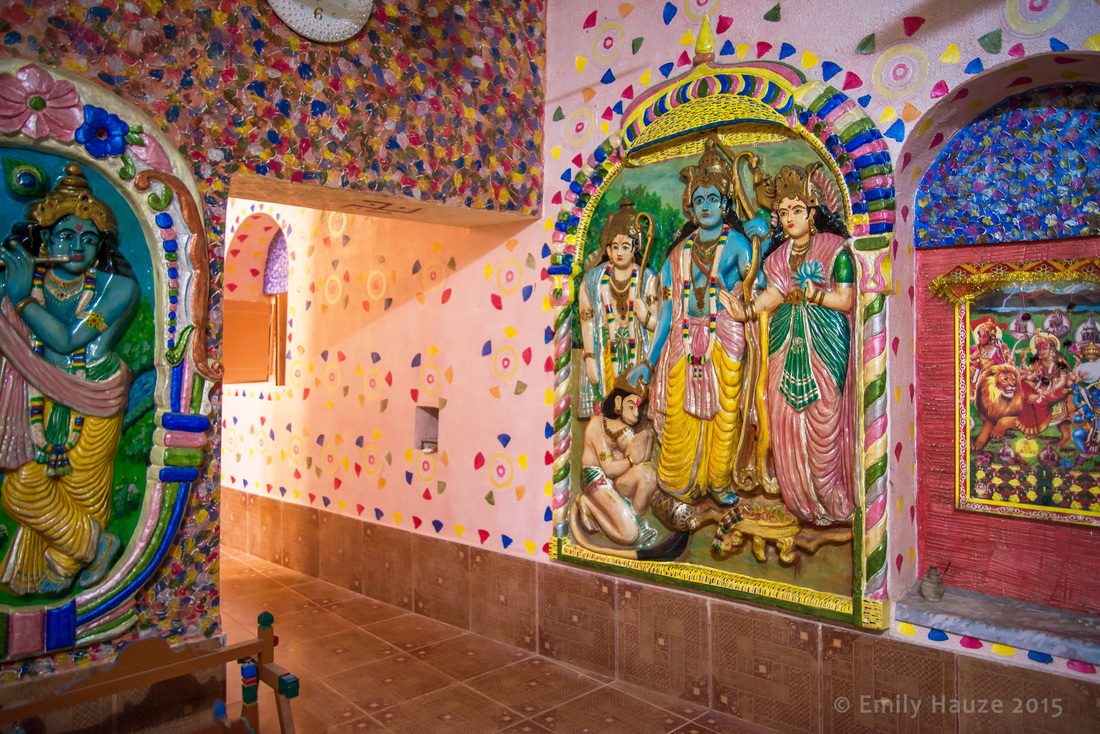
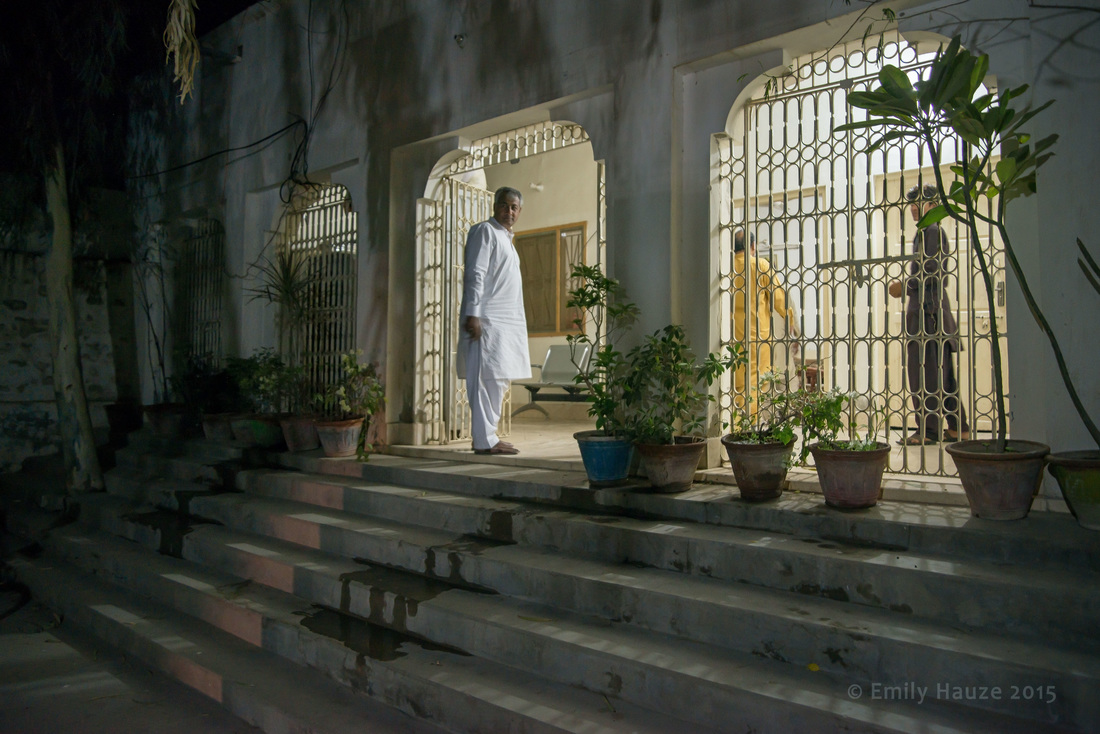



 RSS Feed
RSS Feed
